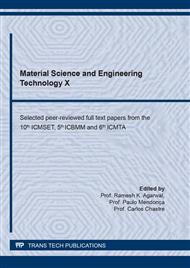p.185
p.191
p.199
p.205
p.212
p.218
p.225
p.232
p.238
A Polynomial Equation Model for Fatigue Crack Propagation in an Aeronautical Steel Material
Abstract:
The model widely used in the fatigue crack growth study in materials science and fracture mechanics is the Paris-Erdogan, which relates the stress intensity factor with the subcritical crack growth, under a fatigue regime. In this work, a seven degree polynomial is used as an alternative to model the crack propagation behavior and to be able to analyze the three regions charts of the cycles by load, in contrast to the common model that it performs at a slight approximation of the propagation phase of the trinca (region II). Finally, a comparison has been made between the proposed model and the secant method by the ASTM 647,2000 standard that adjusts the points obtained experimentally. This proposed equation is new as another alternative analytical model for which the adjustment parameter “R” are compared in relation to the classical approach in a aeronautical ABNT 4130 steel.
Info:
Periodical:
Pages:
212-217
Citation:
Online since:
February 2022
Price:
Сopyright:
© 2022 Trans Tech Publications Ltd. All Rights Reserved
Share:
Citation:


